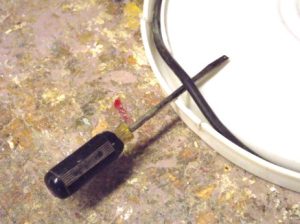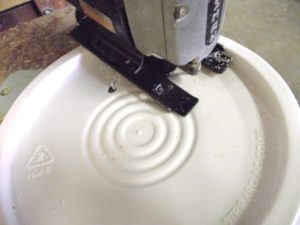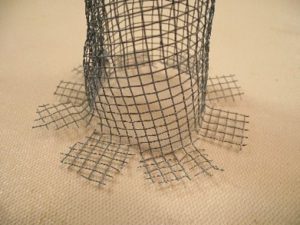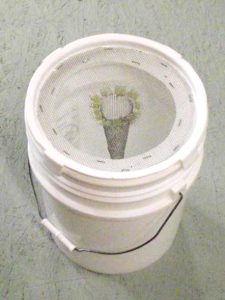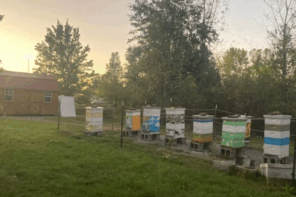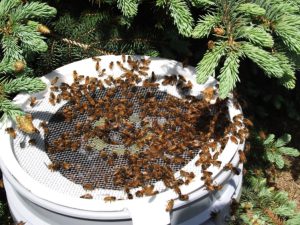 By: Ed Simon
By: Ed Simon
You have just caught a swarm, and now it seems as though there are more bees flying around and crawling out of your container than there is inside. How can you get them into the container without releasing the bees already in it? All you can normally do is wait until dark when the swarm finally moves into the container.
In the future, the easy solution is to start with a five-gallon pail that employs a funnel or cone lid to trap the bees and not allow them to exit. The funnel acts as a one-way opening. It makes use of the bee’s inability to recognize a small opening that is not on a flat surface as an exit. The same concept (cone entrances) is used in many bee related devices such as pollen traps and escape boards. Here is a cheap and easy way to make such a device.
Parts
- Plastic bucket with a lid – 5-gallon size
- 8 mesh hardware cloth – ⅛” holes
- Pop rivets and silicone sealant
Construction
We will build a bucket that has a screened top with a funnel in the middle. The top is modified by removing the sealing gasket and half the top locking tabs. Then a large hole is cut in the top and a screen with a funnel is attached.
Step 1: Remove the seal/gasket.
A gasket is almost always located under the locking rim of the bucket lid. Remove this gasket. There is no need to keep the bucket hermetically sealed when you are going to put a big, screened hole in the top.
Step 2: Cut the hole for the screen/funnel.
Drill a starting hole in the lid, and then use your scroll saw to cut a bigger hole in the top. Make this hole as large as possible while still having room to attach the screen.
Hint: Use the outside rim of the lid to guide the saw. It makes for a nice, neat hole.
Step 3: Remove some of the locking tabs.
The locking tabs make it very difficult to remove the lid. What you don’t need is to be fumbling around with the lid while the bees inside are getting madder and madder. The best way to make the lid removal easier is to cut most of the tabs off, at the same time, leaving the sealing ridge to keep the bees in. The buckets I’ve been using have eight distinct locking tabs. I completely remove every other tab. This leaves four locking tabs. One at each corner. (Did you know that circles have corners?) Continue by cutting all but 1½” off each of the remaining tabs. This makes for a very easily removable lid that will still remain locked in place.
Note: Remove the locking tabs a few at a time. You want the lid to be easy to remove and at the same keep the lid rigidly attached to the bucket.
Step 4: Cut the top screen.
Use the lid as a pattern and cut the hardware cloth (part 2) to fit inside the top ridge.
Step 5: Add the screen to the top side of the lid.
Use long staples to allow you to crimp the staple on the underside of the lid.
Hint: Us a scrap piece of polystyrene insulation under the lid to stop the staples from attaching the lid to your workbench.
Step 6: Protect your fingers.
Turn the lid over and crimp the staples so they will hold the screen in place.
Step 7: Create a funnel from the hardware cloth (part 2).
Make the funnel about seven or eight inches long and taper it from a 1½” opening to a ½” opening on the other end. Pop rivet the hardware cloth into the funnel shape.
Step 8: Add a mounting flange to the funnel.
After the funnel is complete, use a pair of tin snips to put a flange on the large end of the funnel. Then, using the inside edge of the flange as a guide, cut a hole in the center of the top screen. Slip the funnel into the hole from the top and use pop rivets to hold it in place.
Step 9: Protect your fingers.
Smooth silicone sealant over the sharp edges of the flange to protect your fingers.
Step 10: Allow the silicone sealant to dry and you have an especially useful piece of equipment.
Easy, wasn’t it!
This easy to build inexpensive device will get a lot of use during the swarming season.
Usage
After initially getting the swarm into the bucket, put the top on, trapping the bees. Then set the bucket near where the swarm was originally caught and wait. Assuming you caught the queen, eventually all the bees in the swarm will try to get close to her. They will walk down through the large end of the funnel and be unable to exit the bucket.
Thoughts
Have more than one swarm bucket handy. In the past three years, I have come to rely on this device for most of the swarms I have caught. Twice during the peak swarming season, I have been called out on a second swarm retrieval before I was able to hive the first swarm. One time the swarm was so big and difficult to get that I missed the queen on the first try. The bees outside the bucket immediately started to return to the original swarm location. I put the lid on this first bucket and used a second bucket to get the queen and the remainder of the swarm.







